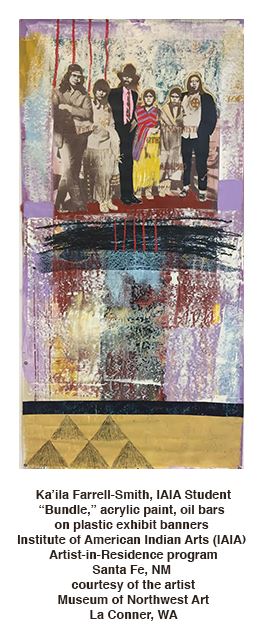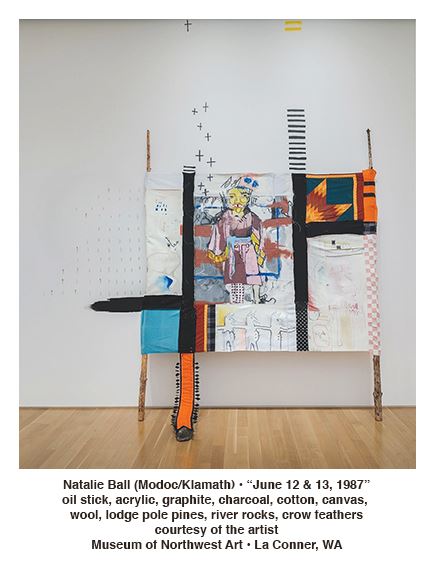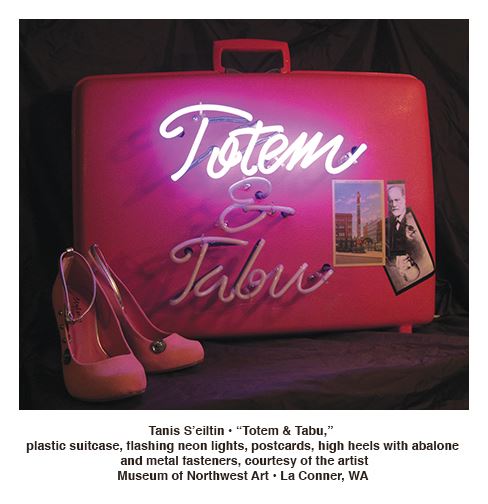 RYAN! Feddersen reaches out both geographically and conceptually for the intriguing show “In Red Ink” at the Museum of Northwest Art in La Conner. She breaks down boundaries of media, chronology, and above all clichés.
RYAN! Feddersen reaches out both geographically and conceptually for the intriguing show “In Red Ink” at the Museum of Northwest Art in La Conner. She breaks down boundaries of media, chronology, and above all clichés.
John Feodorov’s “Dance of the Colonizers,” made up of clips taken from the 1949 film, “On the Town,” exposes the racism of Hollywood as sailors team up with “girls” at the Museum of Natural History in New York City to mimic “savages. Caricature of caricature frequently appears in this exhibition. Andrea Carlson whose affiliation is the central Canadian and East Coast Anishaabeg/Algonquin, sends up the absurd cowboy and Indian stereotypes of dramatically leaping horses and men. Her style of pseudo cartoon, with heavy outlines and brilliant color, underscores her parody of popular culture.
Natalie Ball literally cuts up clichés in her large collaged art work that include river rocks, crow feathers, wool, and lodge pines, an intentional use of traditional Indigenous materials, along with European style painting, charcoal and oil stick on canvas. The central figure appears to be an “Indian” collaged and sewn together from mismatched pieces. It has the expressionist directness of a work by Jean-Michel Basquiat.
Also collage-like and humorous, but entirely painted, is the series of works by Ka’ila Farrell-Smith (from the same tribal affiliation as Natalie Ball, Modoc, Klamath) with her three large “bundle” paintings painted on plastic exhibitionbanners. The term “bundle” is applied to various entities “Time,” “Chief,” and “IAIA Students.” IAIA stands for Institute of Indian Arts in Santa Fe, a renowned Indian Art School. A bundle of sticks appears below them, amusingly transposed as the group of students who themselves echo, in their clothes, a mix of the contemporary and traditional.
Northwest artists Tanis S’eilten and Joe Feddersen both provide humor with less caricature and more politics, S’eilten by her crazy medium in “Totem and Tabu,” a Freudian book title, with pink shoes, pink suitcase, and neon referring to the stereotype of Native sexuality. She inserts the rip off of Native cultures with an old postcard of the stolen totem pole that came to Pioneer Square as a literal totem. Joe Feddersen’s show stopper, “Charmed,” a wall of symbols cast in glass, gives us a delightful mix up of high tension wire towers, petroglyphs, “teepees” and various other “symbols” that can be read as either caricatures or real objects.
On a serious note, John Feodorov’s second group of works reinterpret both media and content. Weaver Tyra Preston created special plain white Navajo rugs for him on which he painted with some trepidation given the rugs’ powerful importance as metaphor of land and culture. The four “Desecrations,” refer to pollution on the land: a coal plant, pipe lines, a yellow radiation house and fracking cracks in the earth.
 Other serious works include the photographs of Matika Wilbur that document contemporary tribal members in a long running project. Amy Maleuf (Metis, another Canadian affiliation), whose” Iamthe caribou/the caribouisme” offers two small braids of caribou and her own hair that refer to the reciprocity of humans and animals. With the dramatic summer of Tahlequah holding her dead baby Orca for 17 days, we are all painfully aware of the threats of extinction to Orcas and other animals. In the medium of glazed ceramic Erin Genia addresses toxic oil leaks in “Facing/Not Facing: Toxic Devastation from Oil.”
Other serious works include the photographs of Matika Wilbur that document contemporary tribal members in a long running project. Amy Maleuf (Metis, another Canadian affiliation), whose” Iamthe caribou/the caribouisme” offers two small braids of caribou and her own hair that refer to the reciprocity of humans and animals. With the dramatic summer of Tahlequah holding her dead baby Orca for 17 days, we are all painfully aware of the threats of extinction to Orcas and other animals. In the medium of glazed ceramic Erin Genia addresses toxic oil leaks in “Facing/Not Facing: Toxic Devastation from Oil.”
RYAN! Feddersen herself has a rye sense of humor, an impatience with historical stereotypes, a deep commitment to redefining what we mean by contemporary Indigenous art, and a generous spirit that reaches out into the community. Her show reflects these qualities. Curated in collaboration with Chloe Dye Sherpe of the Museum, it gives us a refreshing new point of view, while also making us think about the history of indigenous misrepresentations.
We are so fortunate to have contemporary Native artists who speak to both their heritage and to our contemporary world about the state of the earth and the colonialism that has led us to where we are now. Humor traditionally masks politics and urgency. “In Red Ink,” a term that can mean emergency, editing out, deficits, and highlighting, all at once, gives us a chance to understand where we are now and where we can go, with the guidance of these creative artists.
Speaking of that creativity, look out for “yəhaw̓,” an exhibition of 200 indigenous artists sponsored by the Office of Arts and Culture and the Na’ah Illahee Fund, opening at King Street Station in January 2019.
Susan Noyes Platt
Susan Noyes Platt writes a blog www.artandpoliticsnow.com and for local, national, and international publications.
The Museum of Northwest Art located at 121 First Street in La Conner, Washington, is open Tuesday through Saturday from 10 A.M. to 5 P.M., and Sunday through Monday from 12 to 5 P.M. For more information, visit www.monamuseum.org